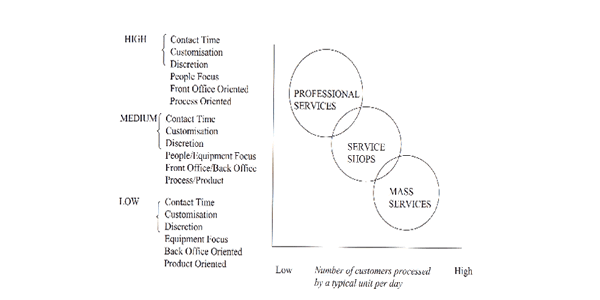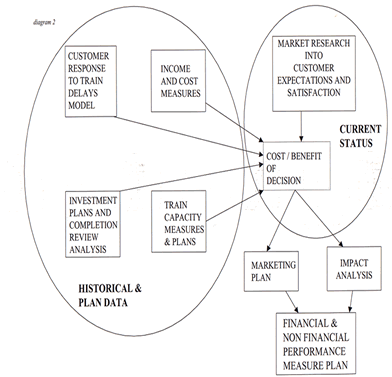 |
Economic Performance Measurement of Customer |
|
|
|
|
Two of the main topics in accountancy in recent years that have a strong economics focus are modern methods of Performance Measurement and introducing a Customer and Strategic Focus into the decision making used by the firm. With Performance Measurement, CIMA (the Chartered Institute of Management Accounting) has sposered research into how the best performance management systems include non-financial as well as financial performance measures. The logical result of this is to link the non-financial and qualitative measure into the companies concerned stated strategic goals. With Customer Focus, the need for companies to consider decisions in terms of whre the extra customers are coming from, or how key customers will react to a strategy. |
||
|
Theory is fine, and at least with research studies you get some examples that can be applied against the theory. However, consider this limitation. To implement a decision-making model that relies upon customer focus and qualitative performance measures assumes an economic environment of the firm that approaches perfect competition. How many companies can directly relate what the firm decides to do to customer behaviour? Many organisations, espcially those who are small parts of large companies, have little or no say on who their customers are. This often extends to limited decision making power over what to make and how much to sell it for. |
||
|
Does this mean that we should only apply these techniques to organisations that operate totally in an open market? Satisfying customers is just as significant to an organisation that is part of a large company as this will still determine success or failure. It is just the techniques used to measure performance that need to be adjusted. In fact, the techniques are likely to be more complex and more sophisticated. One piece of evidence for this is that Management Accountants tend to be in greatest demand in companies that are not straightforward. Analytical tools are required because of the complexity of the business. |
||
|
The purpose of this article is to look at two examples of how in practice a customer focus can be developed, along with relevant performance measurement. The examples are one service sector and one manufacturing. This is a deliberate choice as we can see the similarities in choice of solution and the issues that were faced. Conclusions can then be drawn on the benefit to the company and the impact this has on Economists and Management Accountants. |
||
|
THE SERVICE COMPANY |
||
|
For our service company example lets take a passenger train company that wants to make investment decisions on how to improve its trains. It would have a mission statement that focussed on customers. This may be on how it would improve their travel experience or that it would attract so much market share from car drivers. What sort of performance measures should it use to measure this and how can it make decisions in a way that refers to its stated strategy? |
||
|
The traditional reasoning behind the sort of measures such a passenger train company should use would be like this. This was identified in the CIMA published book Performance Measurement in Service Industries: Making it work by Fitzgerald & Moon. Diagram 1 shows the clasification scheme used to distinguish between different types of service industries. |
||
 |
||
|
Therefore, our company fits into the model as a mass service provider. In terms of traditional cost accounting, it is likely that this would be interpreted as a case for overhead cost control. This implies little focus on customers or customer profitability. It is likely to treat income as a given factor determined by external forces (e.g. economic growth). Pricing decisions are likely to be considered only in terms of capacity pricing, given the low marginal cost of additional customers. |
||
|
If we accept this reasoning then we have a problem in developing a performance measurement package that can relate to a stated customer focus strategy. Do we argue that a strategy of a mass service treating customers as if it were a professional service is wrong? If there is a business benefit to be gained from a people rather than a product focus, which modern management beliefs would tend to favour, then there is a need to do this. For instance, customers tend to see good service in terms of the individual treatment that they get. This applies even where there is a large or dispersed customer interface, such as with a call centre. |
||
|
Performance measurees that a mass service will find easy to use such as efficiency (e.g. in our example train punctuality) at best can only be used as a proxy for customer related measures. This proxy would develop links between efficiency and cost indicators that cna be measure directly and dynamic models of how the customers behave. The sort of dynamic models that could be used were outlined by Davis & O'Donnell in the May 1997 Management Accounting, using the example of an airline. |
||
|
Market Research plays an important part in developing these proxies. Using a research methodology such as the SERVQUAL one developed by Parasuraman, Zeithmal & Berry allows expectations of customers as well as service delivery to be measured. This also allows weightings to be applied to the different elements of customer service. Thus, a link between the financial impact of efficiency in terms of customers and the other elements of customer service can be estimated. In our example, the train company would use information on train delays and the compensation it paid to customers for these delays. To get the compensation the customer would complete market research which would gather information on how the customer felt about the delay compared to the other elements of the customer service they had received. |
||
|
This provides some base information in terms of measuring the overall performance. At the same time, the organisation would benchmark itself against its competitors in terms of both price and the elements of its customer service it had identified (from its customers) as being important. In our example, we can compare to airlines, coaches,cars and even not making a journey at all. From this information we can start to develop a decision making model which describes the flow of how the performance measures are used and how they relate to each other. (see diagram 2). |
||
 |
||
|
In practice, this sort of model operates as a learning experience. Feedback on success of marketing a particular improvement allows the whole company to focus on its strategic goal. The result is a model that incorporates financial and non-financial performance indicators. It includes a financial forecast of the impact of a piece of investment that can be monitored by each responsible department in an organisation. The level of analysis it covers is not only long term items such as a strategy review but also short term areas such as the effect of a strike at a competitor. |
||
| THE MANUFACTURING COMPANY | ||
|
For our manufacturing company, let's take the example of a production site for a large multinational consumer electronics comapny. It is likely to do much of its business within the multinational group. It buys parts from internal procurement organisations and sells finished appliances to internal sales organisations. |
||
|
In this circumstance, traditional theory suggests the financial measures of performance are likely to have limited meaning. If you can't decide what to make and who to sell to then a customer focus may appear to mean very little as part of devision making. As with our service company, a process focus would seem likely to dominate. |
||
|
The CIMA research study Performance Measurement in the Manufacturing Sector split non-financial performance measures into those covering Quality, Delivery, Process Time, Flexibility and Cost. The Cost measure was seen in terms of Internal and External Benchmarking. From a process focus, this would be consistent with our scenario. Our company would seem at first glance to be dominated by internal comparisons, especially efficiency measures compared with equivalent plants in the group in other countries. |
||
|
The financial performance measures that accompany these process-oriented measures would traditionally be the use of standard product costs and variance analysis against these standards. Increased sophistication of such measurement tools through the use of Activity Based Costing, for instance, would be unlikely to make financial information as improtant to the decision making of the company as the non-financial efficiency measure. This is particularly so against the internal benchmarks that are likely to dominate. |
||
|
This may seem straightforward, but it is also misleading. Almost every multinational company will have a customer focus as part of its global strategy and we can assume this is the case here. The Head Office will ensure buy-in to the strategy through insisting that the production company has a complimentary customer focus in its own strategy. This is established through control processes and will be reflected in the performance measures used. For instance, the production site will be monitored by head office on the batch rejection rate by the end customer of the goods produced. |
||
|
In addition, the financial performance measure cannot be ignored. Research studies suggest that even in this comapny bottom line profit and return on capital employed are likely to be the most important performance measures. Success is still seen in financial terms. This company cannot control profit margin and prices. As with the service company example, we have the need for overhead control. The same problem is faced, how to reconcile financial focus on overheads with the business focus on end customer? How can the company determine what overheads are required to achieve good customer service? |
||
|
As with the service company we cna build a dynamic model that allows the financial performance indicators of the business to be seen in terms of the non-financial measures. In the manufacturing case you could drive both long and short term plans from customer delivery targets, production targets and product defect targets. Changes in these measures can all be additionally interpreted in financial terms. A plan to achieve deliveries to customer will need to be linked to production and procurements plans in financial terms by the use of assumed sales prices and product costs, along with assumptions on production defect and achievement rates. |
||
|
The importance of this is that it helps to keep the focus on the customer goal without losing the manufacturing sites natural inclination to focus on the process. It also recognises the financial impact of decisions without pretending that finances are driving the decision. For example, the impact of reducing expenditure on production support can be viewed in terms of what impact on defect rates result. It will also help with internal communication with Head Office, especially explaining the effect in financial terms of Head Office driven decisions. If frequent product changes affect defect rates, where this decision was driven from needs to be recognised. |
||
|
CONCLUSIONS |
||
|
I have attempted to identify two examples of how theory and research on performance measurement and customer focus can be used. I deliberately chose extreme examples from service and manufacturing where the key decisions would appearr to be removed from local control. In both cases, we needed to find a proxy for customer focus given the inability to choose customers or determine prices. The approach was fundamentally the same for both examples; look at what you can easily measure and develop links between the measures. The company benefits through having a standard approach to decision making that keeps a strategic focus on the customer. |
||
|
This brings us to the role of economists in businesses and management accountants in the process. In both examples the organisation had various different departmental business models, the production plan link to defect rate and the train capacity models being examples. As in most organisations, it is likely that the reporting of performance measures is reviewed by department as well as collectively. Therefore, it makes sense to keep responsibility for these business models within each department. The forecasting model is just the business model operated by the finance department. The additional role for economists and finance staff comes from maintaing the links between different models (in effect management of the overall performance measurement system) and ensuring co-ordination and compliance across the organisation. |
||
|
|
||